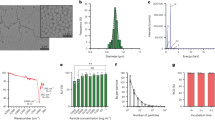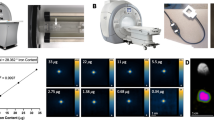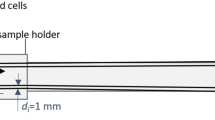Abstract
In vivo molecular imaging can measure the average kinetics and movement routes of injected cells through the body. However, owing to non-specific accumulation of the contrast agent and its efflux from the cells, most of these imaging methods inaccurately estimate the distribution of the cells. Here, we show that single human breast cancer cells loaded with mesoporous silica nanoparticles concentrating the 68Ga radioisotope and injected into immunodeficient mice can be tracked in real time from the pattern of annihilation photons detected using positron emission tomography, with respect to anatomical landmarks derived from X-ray computed tomography. The cells travelled at an average velocity of 50 mm s−1 and arrested in the lungs 2–3 s after tail-vein injection into the mice, which is consistent with the blood-flow rate. Single-cell tracking could be used to determine the kinetics of cell trafficking and arrest during the earliest phase of the metastatic cascade, the trafficking of immune cells during cancer immunotherapy and the distribution of cells after transplantation.
This is a preview of subscription content, access via your institution
Access options
Access Nature and 54 other Nature Portfolio journals
Get Nature+, our best-value online-access subscription
$29.99 / 30 days
cancel any time
Subscribe to this journal
Receive 12 digital issues and online access to articles
$99.00 per year
only $8.25 per issue
Buy this article
- Purchase on Springer Link
- Instant access to full article PDF
Prices may be subject to local taxes which are calculated during checkout




Similar content being viewed by others
Data availability
The main data supporting the results in this study are available within the paper and its Supplementary Information. The raw PET–CT data (list-mode format) are available from the corresponding author on request.
Code availability
The computer codes used to reconstruct cell trajectories from list-mode PET data are provided in the Supplementary Information, and are also available as an online Code Ocean capsule25 at https://doi.org/10.24433/CO.5746631.v1.
Change history
25 June 2020
In the version of this Article originally published, the Reporting Summary was outdated. This has now been replaced and the updated version is available online.
References
Kircher, M. F., Gambhir, S. S. & Grimm, J. Noninvasive cell-tracking methods. Nat. Rev. Clin. Oncol. 8, 677–688 (2011).
Eckhardt, B. L., Francis, P. A., Parker, B. S. & Anderson, R. L. Strategies for the discovery and development of therapies for metastatic breast cancer. Nat. Rev. Drug. Discov. 11, 479–497 (2012).
Dimmeler, S., Burchfield, J. & Zeiher, A. M. Cell-based therapy of myocardial infarction. Arter. Thromb. Vasc. Biol. 28, 208–216 (2008).
Serup, P., Madsen, O. D. & Mandrup-Poulsen, T. Islet and stem cell transplantation for treating diabetes. BMJ 322, 29–32 (2001).
June, C. H., O’Connor, R. S., Kawalekar, O. U., Ghassemi, S. & Milone, M. C. CAR T cell immunotherapy for human cancer. Science 359, 1361–1365 (2018).
Kupperman, E., An, S., Osborne, N., Waldron, S. & Stainier, D. Y. A sphingosine-1-phosphate receptor regulates cell migration during vertebrate heart development. Nature 406, 192–195 (2000).
Wright, D. E., Wagers, A. J., Gulati, A. P., Johnson, F. L. & Weissman, I. L. Physiological migration of hematopoietic stem and progenitor cells. Science 294, 1933–1936 (2001).
Lehr, H.-A., Leunig, M., Menger, M. D., Nolte, D. & Messmer, K. Dorsal skinfold chamber technique for intravital microscopy in nude mice. Am. J. Pathol. 143, 1055–1062 (1993).
Thurber, G. M. et al. Single-cell and subcellular pharmacokinetic imaging allows insight into drug action in vivo. Nat. Commun. 4, 1504 (2013).
Wang, L., Maslov, K. & Wang, L. V. Single-cell label-free photoacoustic flowoxigraphy in vivo. Proc. Natl Acad. Sci. USA 110, 5759–5764 (2013).
Heyn, C. et al. In vivo MRI of cancer cell fate at the single-cell level in a mouse model of breast cancer metastasis to the brain. Magn. Reson. Med. 56, 1001–1010 (2006).
Hinds, K. A. et al. Highly efficient endosomal labeling of progenitor and stem cells with large magnetic particles allows magnetic resonance imaging of single cells. Blood 102, 867–872 (2003).
Iwano, S. et al. Single-cell bioluminescence imaging of deep tissue in freely moving animals. Science 359, 935–939 (2018).
Adonai, N. et al. Ex vivo cell labeling with 64Cu–pyruvaldehyde-bis(N4-methylthiosemicarbazone) for imaging cell trafficking in mice with positron-emission tomography. Proc. Natl Acad. Sci. USA 99, 3030–3035 (2002).
Doyle, B. et al. Dynamic tracking during intracoronary injection of 18F-FDG-labeled progenitor cell therapy for acute myocardial infarction. J. Nucl. Med. 48, 1708–1714 (2007).
Keu, K. V. et al. Reporter gene imaging of targeted T cell immunotherapy in recurrent glioma. Sci. Transl. Med. 9, eaag2196 (2017).
Parker, D., Broadbent, C., Fowles, P., Hawkesworth, M. & McNeil, P. Positron emission particle tracking – a technique for studying flow within engineering equipment. Nucl. Instrum. Methods Phys. Res. A. 326, 592–607 (1993).
Lee, K., Kim, T. J. & Pratx, G. Single-cell tracking with PET using a novel trajectory reconstruction algorithm. IEEE Trans. Med. Imaging 34, 994–1003 (2015).
Ouyang, Y., Kim, T. J. & Pratx, G. Evaluation of a BGO-based PET system for single-cell tracking performance by simulation and phantom studies. Mol. Imaging 15, 1–8 (2016).
Fani, M., Andre, J. P. & Maecke, H. R. 68Ga‐PET: a powerful generator‐based alternative to cyclotron‐based PET radiopharmaceuticals. Contrast Media Mol. Imaging 3, 53–63 (2008).
Shaffer, T. M. et al. Silica nanoparticles as substrates for chelator-free labeling of oxophilic radioisotopes. Nano Lett. 15, 864–868 (2015).
Liu, J., Jiang, X., Ashley, C. & Brinker, C. J. Electrostatically mediated liposome fusion and lipid exchange with a nanoparticle-supported bilayer for control of surface charge, drug containment, and delivery. J. Am. Chem. Soc. 131, 7567–7569 (2009).
Kim, T. J., Turkcan, S. & Pratx, G. Modular low-light microscope for imaging cellular bioluminescence and radioluminescence. Nat. Protoc. 12, 1055–1076 (2017).
Freedenberg, M. I., Badawi, R. D., Tarantal, A. F. & Cherry, S. R. Performance and limitations of positron emission tomography (PET) scanners for imaging very low activity sources. Phys. Med. 30, 104–110 (2014).
Jung, K. O. et al. Whole-body tracking of single cells via positron emission tomography. Code Ocean https://doi.org/10.24433/CO.5746631.v1 (2020).
Kaul, M. G. et al. Magnetic particle imaging for in vivo blood flow velocity measurements in mice. Phys. Med. Biol. 63, 064001 (2018).
Andreassen, C. N., Grau, C. & Lindegaard, J. C. Chemical radioprotection: a critical review of amifostine as a cytoprotector in radiotherapy. Semin. Radiat. Oncol. 13, 62–72 (2003).
Langford, S. T. et al. Three-dimensional spatiotemporal tracking of fluorine-18 radiolabeled yeast cells via positron emission particle tracking. PLoS ONE 12, e0180503 (2017).
Schmitzer, B., Schafers, K. P. & Wirth, B. Dynamic cell imaging in PET with optimal transport regularization. IEEE. Trans. Med. Imaging 39, 1626–1635 (2020).
Wirtz, D., Konstantopoulos, K. & Searson, P. C. The physics of cancer: the role of physical interactions and mechanical forces in metastasis. Nat. Rev. Cancer 11, 512–522 (2011).
Aceto, N. et al. Circulating tumor cell clusters are oligoclonal precursors of breast cancer metastasis. Cell 158, 1110–1122 (2014).
Choi, J. W. et al. Urokinase exerts antimetastatic effects by dissociating clusters of circulating tumor cells. Cancer Res. 75, 4474–4482 (2015).
Follain, G. et al. Hemodynamic forces tune the arrest, adhesion, and extravasation of circulating tumor cells. Dev. Cell. 45, 33–52 (2018).
Badawi, R. D. et al. First human imaging studies with the EXPLORER total-body PET scanner. J. Nucl. Med. 60, 299–303 (2019).
Yaron, J. R., Ziegler, C. P., Tran, T. H., Glenn, H. L. & Meldrum, D. R. A convenient, optimized pipeline for isolation, fluorescence microscopy and molecular analysis of live single cells. Biol. Proced. Online 16, 9 (2014).
Nejadnik, H., Castillo, R. & Daldrup-Link, H. E. Magnetic resonance imaging and tracking of stem cells. Methods Mol. Biol. 1052, 167–176 (2013).
Acknowledgements
We thank the following individuals for support and assistance: M. Wardak, C. Azevedo, T. Shaffer, H. Li, F. Habte, A. Natarajan, S.-M. Park, T. Doyle and S. Lee. The ShowVol package by D.-J. Kroon was used for surface rendering. This research was funded in part by the National Institutute of Health grants 5R21HL127900 and T32CA1186810. Experiments were performed at the Stanford small-animal imaging facility, the Stanford radiochemistry facility and the Stanford nano facility.
Author information
Authors and Affiliations
Contributions
K.O.J. performed in vitro and in vivo experiments. T.J.K. performed physical tests and processed data. J.H.Y. characterized nanoparticles and optimized their radiolabelling. S.R. imaged ex vivo specimens. W.Z. reconstructed CT images. B.H. contributed to the design of the methods. G.P. reconstructed dynamic cell trajectory data. K.O.J. and G.P. designed the study and wrote the manuscript. K.R.-H., S.S.G. and G.P. supervised the study.
Corresponding author
Ethics declarations
Competing interests
G.P. is listed as inventor on a US patent that covers the algorithm used in this study for cell trajectory reconstruction (no. US9962136B2). The other authors declare no competing interests.
Additional information
Publisher’s note Springer Nature remains neutral with regard to jurisdictional claims in published maps and institutional affiliations.
Supplementary information
Supplementary Information
Supplementary Figs. 1–23 and the captions for Supplementary Videos 1–6.
Supplementary Code
Reconstruction of cell trajectories from list-mode PET data.
Supplementary Video 1
Cell position (red dot) reconstructed from list-mode PET data over time. A single cell (67 Bq) was flown, moving through a length of plastic tubing coiled around a 3D printed cylinder.
Supplementary Video 2
Cell position (red dot) reconstructed from list-mode PET data over time. A single cell (27 Bq) was injected into the forepaw of a mouse.
Supplementary Video 3
Cell position (red dot) reconstructed from list-mode PET data over time. A single cell (30 Bq) was injected into the tail vein of a mouse.
Supplementary Video 4
Cell position (red dot) reconstructed from list-mode PET data over time. A single cell (70 Bq) was injected into the tail vein of a mouse through a catheter, while PET data were acquired.
Supplementary Video 5
Cell position (red dot) reconstructed from list-mode PET data over time. A single cell (70 Bq) was injected into the tail vein of a mouse through a catheter, while PET data were acquired.
Supplementary Video 6
Cell position (red dot) reconstructed from list-mode PET data over time. A single cell (70 Bq) was injected into the tail vein of a mouse through a catheter, then the organs were excised and imaged using PET–CT.
Rights and permissions
About this article
Cite this article
Jung, K.O., Kim, T.J., Yu, J.H. et al. Whole-body tracking of single cells via positron emission tomography. Nat Biomed Eng 4, 835–844 (2020). https://doi.org/10.1038/s41551-020-0570-5
Received:
Accepted:
Published:
Issue Date:
DOI: https://doi.org/10.1038/s41551-020-0570-5



